Fungicide Application and Timing
BY Dairyland Seed Agronomy Team
As rain breaks the long stretches of drought in parts of the Dairyland Seed footprint, heavy dews and hazy mornings bring the potential for disease in both corn and soybeans. The following is not to incite panic, but to help identify issues and provide solutions should they arise.
Corn
Recommended fungicide application timing on corn is VT (tasseling) to R2 (blister or brown silk). We recommend beginning applications once 75 to 80 percent of tassels are visible. Some products allow for an earlier application of pre-tassel, but the VT to R2 window has shown the most consistent control of mid to late season foliar diseases. The single tassel timing application was shown to be the most economical in our 2022 PAR (Product and Agronomy Research) fungicide trial, which is being replicated this year in Wabash, Indiana and St. Johns, Michigan. Fungicide applications made prior to VT and pollination should not contain a non-ionic surfactant as this can cause arrested ear syndrome in corn and greatly reduce yields.
Tar Spot has been confirmed in northern Indiana and gray leaf spot along with northern leaf blight usually settle in around pollination.
The map below was captured on July 11, 2023, and is updated as tar spot is confirmed by county. Tar spot and other corn disease progression maps can be found at the Corn ipm PIPE website.
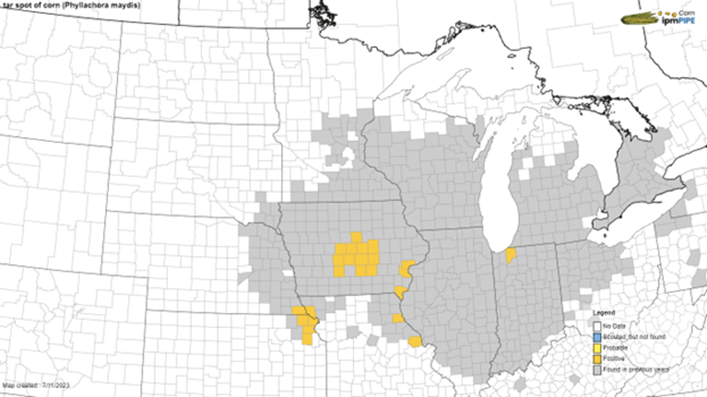
Tar Spot Identification
Target fields that are near or at tasseling and fields that have had tar spot in the past. Look at the lower and mid-sections of the corn plant for lesions on the leaves. Tar spot lesions will be black and circular with raised structures called stromata. These lesions may also be found on the upper and lower side of the leaves, stems and husks of affected corn plants. Be careful not to confuse tar spot with insect frass. Frass is often black and about the same size, but frass will wipe off with a little moisture and rubbing while tar spot will not.
The picture below shows a corn leaf infected with tar spot. We are still learning about tar spot, but one thing that we do know is that it spreads and proliferates with leaf area wetness, rains, heavy dews and hazy mornings, which are indicators to begin scouting fields with past tar spot infections.
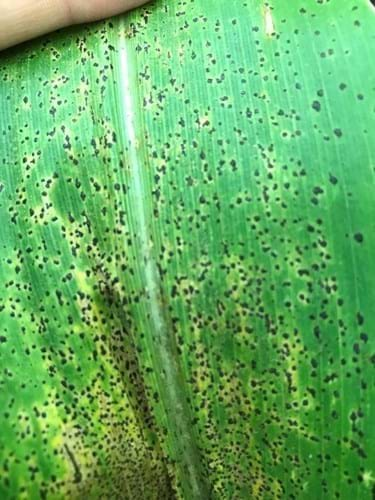
Gray Leaf Spot
Gray leaf spot infection will appear on lower leaves and work its way up the canopy. The lesions of gray leaf spot are rectangular or blocky and two inches in length. Early lesions will be interveinal or between the veins of the corn leaf but as the disease progresses, the lesions will join together and can cover the entire leaf surface.
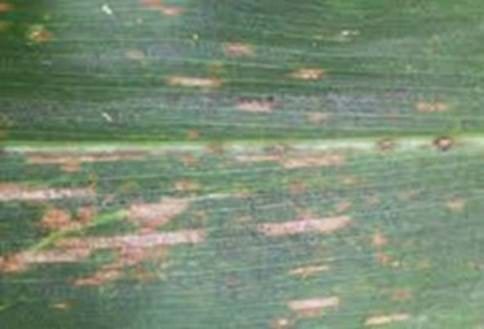
(Photo credit: Purdue University)
Northern Leaf Blight
Lesions of northern leaf blight can first be found on lower leaves of the corn plant and will progress up the plant. Lesions are 1 to 6 inches long, elliptical or cigar shaped, and are gray or tan in color. Spores can be seen in the lesions which can give the lesion a gray or dirty appearance.
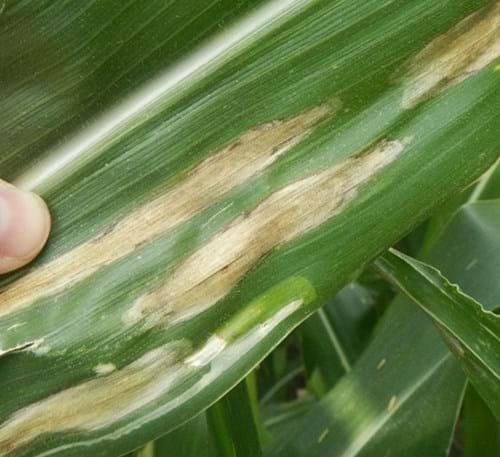
(Photo credit: Purdue University)
Soybeans
Recommended fungicide application timing for soybeans is R2 to R3. A soybean is in R2 when an open flower is visible on one of the top two nodes on the main stem. The soybean has matured to R3 when a 3/16-inch-long pod can be found on one of the four top nodes on the main stem. Two common soybean diseases in our area are Frogeye and Septoria.
Septoria
Septoria brown spot, Septoria glycines, overwinters in crop residue and the plant becomes infected when water splashes the fungus onto the lower leaves of the soybean plant. Symptoms of Septoria are small brown spots and yellowing of leaves in the lower canopy. The brown spots will grow and merge together forming larger brown spots which can cover the entire leaf surface and cause impacted leaves to fall prematurely. Moderate temperatures (60-80°F) and wet conditions favor disease formation. Higher temperatures and dry conditions usually stop disease development.
On average, yield impacts from Septoria infection are less than five bushels per acre. However, if brown spot develops into the middle canopy, the impact can be greater, and a foliar application of fungicide would be warranted.
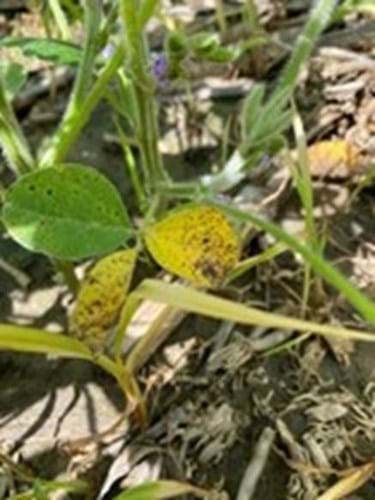
Frogeye
Frogeye leaf spot is caused by the fungus Cercospora sojina which survives in infected crop residue and seed. The spores of this fungus are also readily transported via wind from field to field. Like many foliar diseases, frogeye infection is favored in warm, humid and wet conditions and can occur at any time during soybean development.
Frogeye lesions can appear on leaves anywhere in the canopy but are most typically found on newer leaves. The lesions will be small yellow spots at first, and then grow to about ¼ inch with gray centers surrounded by reddish-brown margins. Frogeye can progress and infect the stem and pods of soybean plants as well. On the stem, a reddish-brown and sunken lesion will appear and spots on the pods will resemble the lesions on the leaves.
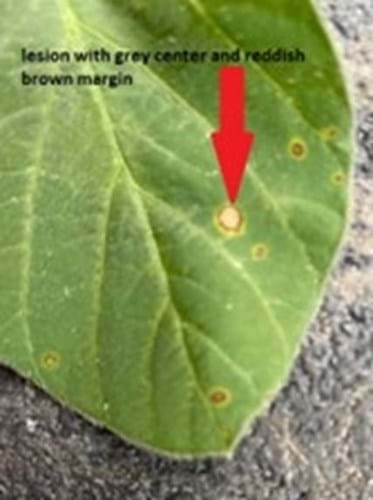
The loss of viable leaf tissue can be detrimental to yield, and infected pods can lead to damaged seed. Impacted seed can be dark and shriveled with damaged seed coats. Depending on the extent of the damage, this can lead to decreased grain quality.
Treatment at R3 growth stage with foliar fungicides has shown best results in limiting the impact of frogeye. There are documented cases of resistance to Group 11 Qol (Quinone Outside Inhibitor) commonly referred to as Strobilurin chemistry. The application of fungicides with multiple modes of action is recommended to avoid resistance and provide the best control.
There are many diseases that can impact our area and the diseases listed in this article are just a few that are common in any given year. If you have questions, please contact your Dairyland Seed DSM or Regional Agronomist for more information.
Product Recommendations
There are many high-quality fungicides available to us today. Best management practices dictate that we do our best to negate resistance. As stated above, resistance to certain fungicides has already been found and in our experience with weed resistance we know that applications of multiple modes of action allow us to use the tools we have for a longer period before resistance occurs. We recommend the use of approved fungicides with multiple modes of action to ensure yield protecting control of the disease as well as mitigate the potential for resistance.

Brian Weller
Western Region
507.456.3034

Rod Moran
Western Region
507.456.3034

Dan Ritter
Central Region
219.863.0583

Branden Furseth
Northern Region
608.513.4265

Mark Gibson
Eastern Region
260.330.8968

Amanda Goffnett
Eastern Region
989.400.3793

Ryan Mueller
Eastern Region
989.400.3793
